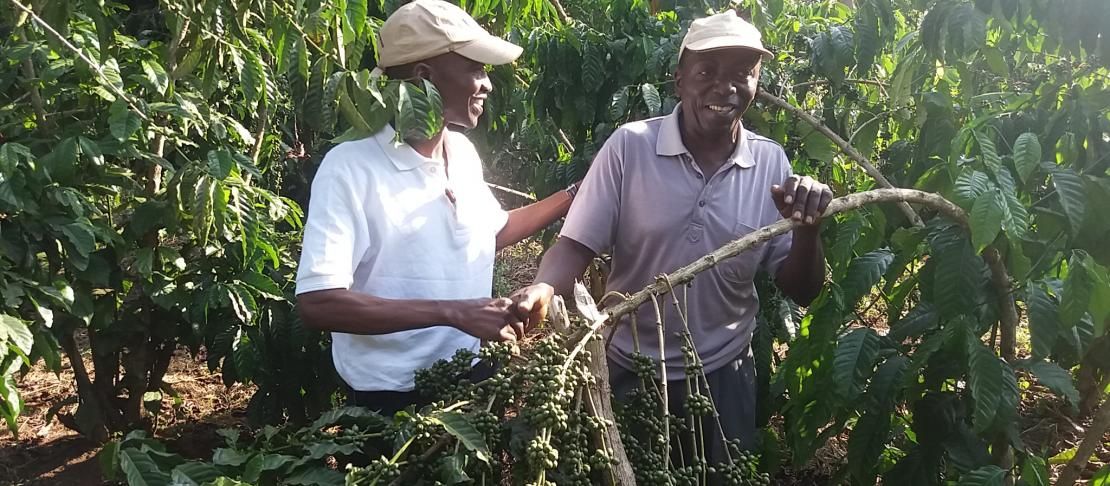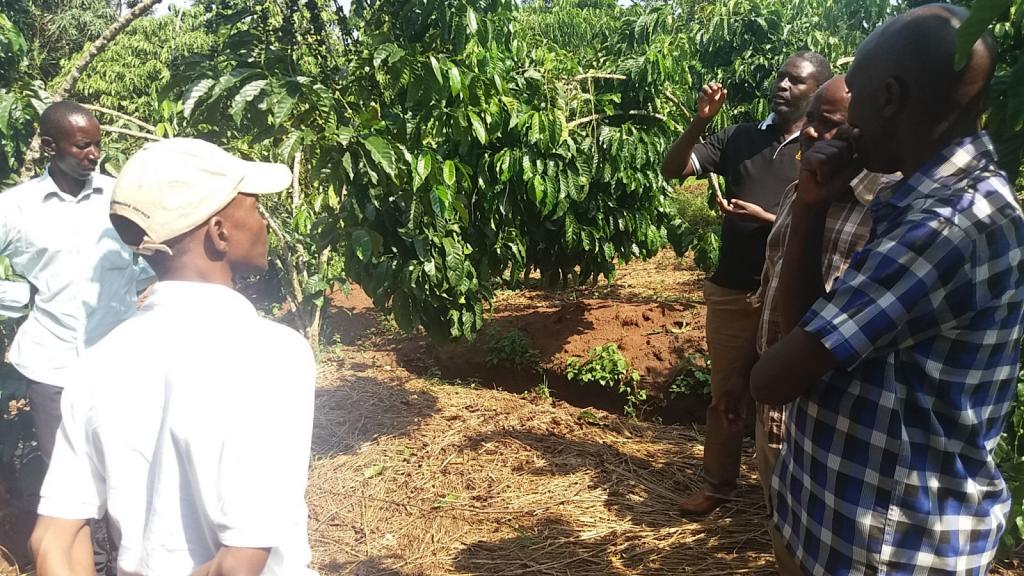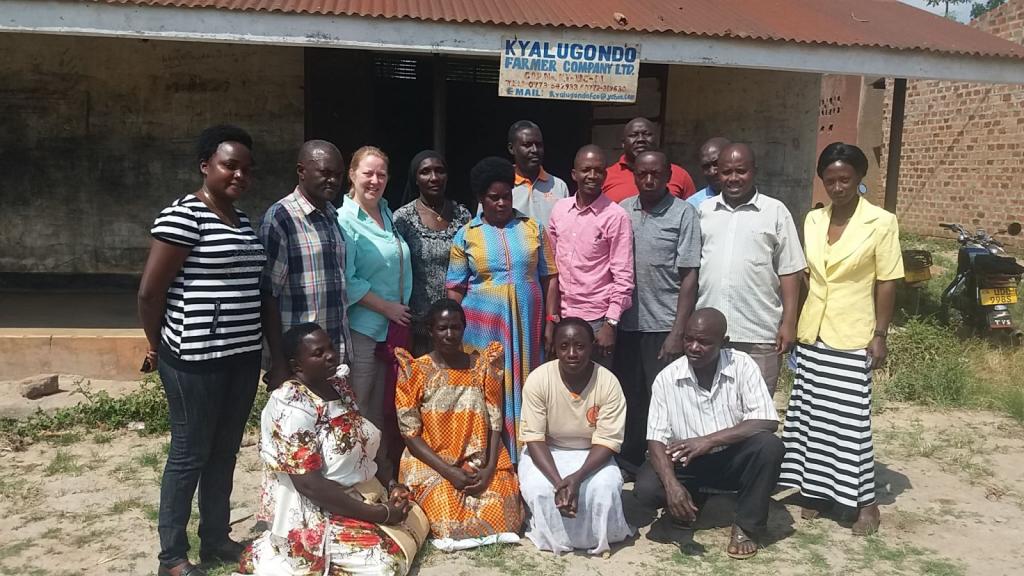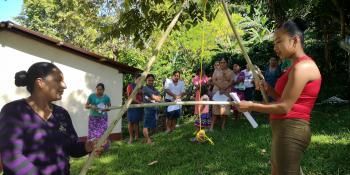A learning exchange for improved extension to coffee farmers

Two pilot interventions in Uganda share experiences of promoting climate-smart practices to coffee farmers
Earlier this year in July, the International Institute for Tropical Agriculture (IITA) Uganda and partners met to share learning and experiences from the Climate Smart Investment Pathway pilot in Luwero, Central Uganda. This approach has been jointly developed by IITA and partners and has come to be known as the Stepwise approach, or simply Stepwise.
The research on Stepwise is being done in collaboration with Hanns R. Neumann Stiftung (HRNS) on Robusta coffee in Luwero, Central Uganda; and with Olam Uganda on Arabica coffee, on the slopes of Mt. Elgon in Sironko District, in the Eastern part of the country.
One goal, two structures
Both HRNS and Olam provide extension support services to smallholder coffee farmers for the improvement of livelihoods through increased coffee production. Each has its own structure:
The HRNS model consists of a 3-tier organizational structure established at grassroots level to provide technical and commercial services to farmers. Contact farmers are identified at village level and trained to facilitate farmer field school meetings, which provide access to approximately 25-30 farmers. Extension agents are then attached to each of the second tier organizations (depot committees) and charged with monitoring and back-stopping 4-5 farmer field school contact farmers each. Extension agents also play a role in assisting depot committee marketing managers in coffee bulking at village level for further processing and marketing directly to exporters. HRNS provides support to coffee farmers through regular on-farm trainings and technical back-stopping to the depot committee extension agents. For more on the HRNS program in Uganda click here.
Olam’s farmer support is delivered through a team of Olam field-based coordinators (FBCs) offering training and in-field technical support. The Olam farmer groups also consist of between 25-30 members, who are supported in the establishment of demonstration plots. A demonstration plot typically serves 150 registered farmers who regularly receive training at those locations. For more on Olam click here.
For both HRNS and Olam, access to finance is a key challenge for smallholder farmer adoption of the whole package of the recommended climate-smart and good agricultural practices. In response to this particular challenge, the IITA Uganda team designed the innovative Stepwise approach.
Comparing notes
Experiences differ in the two Stepwise pilot sites in terms of the status and organization of demonstration plots. These differences were the motivation for the learning visit, so that partners could share and compare their experiences so far.
During the project visit, participants discussed the advantages of working with Village Savings and Loans Associations (VSLAs). VSLAs bring farmers together on a regular basis to save and share information. The increased access to income that VSLA membership offers gives farmers increased opportunities to invest in climate change practices that might otherwise not be adopted.

David Mukasa from IITA explains the different sets of Stepwise practices in a Luwero demonstration plot. Photo: Victor Komakech (HRNS)
Olam recognised that the HRNS lead farmers demonstrated a good level of capability in the application of the Stepwise approach and a spontaneity in presenting which practices were being applied independent of the project team support. This may be indicative of the long-term relationship HRNS has had with the farmers in Luwero, which has contributed to a sustained learning environment.
Both organisations are pursuing formal engagements with farmer groups in the form of written Memoranda of Understanding (MoUs). The purpose of having this more formal engagement is to ensure clarity on roles and responsibilities of each partner. An MoU is not legally binding for either party, but rather works to reinforce commitments to the relationship and ensure expectations are agreed, streamlining the engagement between the company and farmer group, thus support a longer-term relationship.
A particularly impressive aspect of the meeting with the Luwero Depot Committee was the involvement of a large group of female extension officers. Many of the extension officers in Luwero are women who have actively participated in climate change dialogue and have demonstrated the early adoption of the Stepwise approach on their own farms.
Both Olam and HRNS are working to ensure gender mainstreaming in their respective programs.

The visiting team from IITA, HRNS and Olam, together with farmers and extension workers from the Kyalugondo Farmers’ Cooperative. Photo: Victor Komakech (HRNS)
The Olam representatives also showed appreciation for the Stepwise implementation in Luwero. Roy Okumu, Olam’s Zonal Manager, said of the visit that the learning shared was "exceptionally enriching," especially "at a time when approaches and adoption strategies to field extension are becoming more complex to comprehend and practically implement." Roy went on to observe that our continued learning through strategic partnerships and mutual collaboration is key to building a resilient supply chain for the private sector.
The Olam team observed from dialogue with the Luwero farmers piloting the Stepwise approach that demonstration plots play a pivotal role in sharing evidence of new climate-smart technologies, offering "powerful visual evidence" to farmers, which essentially drives quicker adoption of new practices.
The importance of having clear performance indicators was well appreciated by the Olam team. In addition, there was a good deal of discussion about the value of continuous and robust monitoring and evaluation throughout the process. Overall, the role research plays in providing evidence for improved adoption of climate-smart agricultural practices was said to be very evident from the IITA/HRNS Stepwise collaboration.
The learning visit was so successful the Olam Zonal Manager invited the HRNS team and key demonstration host farmers to a similar exchange visit in Mount Elgon, so that the Olam field team can share their experiences of the Stepwise approach. The team looks forward to bringing you news of such a visit in the near future.
The Luwero project visit took place on 29 July 2018. It was led by Victor Komakech of HRNS, the Alliance for Resilient Coffee Project Manager, and his colleague Charles Lwanga, Coffee and Climate Technician. The Olam team was led by Roy Okumu, Olam’s Zonal Manager, who was accompanied by Dorcus Nabulime, the Olam Project Certification and Traceability Coordinator, and Alex Jigga, Olam Agronomist.
The project is supported by Alliance for Resilient Coffee (ARC) and BMZ in Uganda and contributes to the global CGIAR Research Program on Climate Change, Agriculture and Food Security (CCAFS).
Sarah Margiotta is the IITA Uganda CCAFS Learning and Communications Advisor and David Mukasa is an IITA Researcher.



